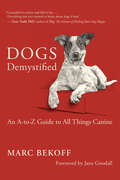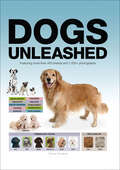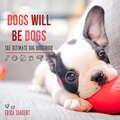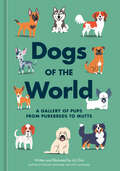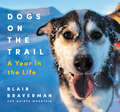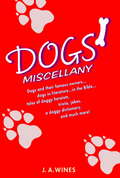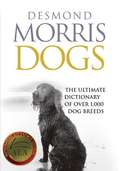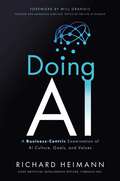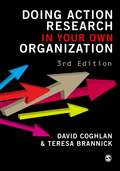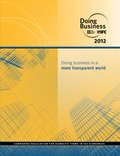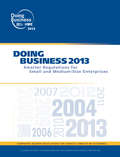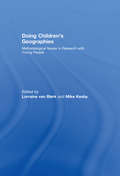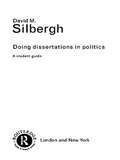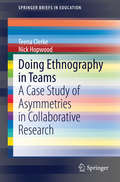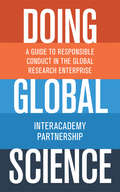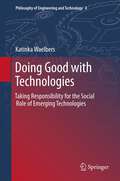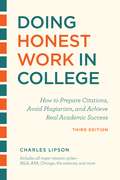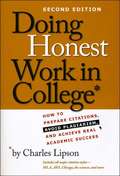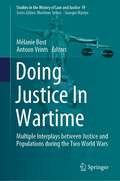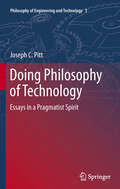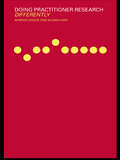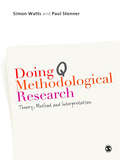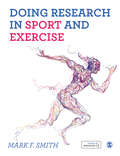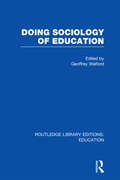- Table View
- List View
Dogs Demystified: An A-to-Z Guide to All Things Canine
by Marc BekoffAn all-encompassing and fun reference from an award-winning scientist and dog lover Dr. Marc Bekoff is an expert at turning cutting-edge science into practical, reader-friendly information. The encyclopedic entries in this book cover everything related to dog care, dog-human relationships, and dog behavior, cognition, and emotions, making this the accessible book that every dog lover should have. In concise, readable A-through-Z entries, Bekoff covers it all, from aggression to pack formation to zoomies, and explores why dogs do what they do; exactly how to meet any dog eye-to-eye, nose-to-nose, and ear-to-ear to understand their world better; and how tuning in to a dog’s unique personality leads to happier dogs and happier human companions.
Dogs Unleashed
by Tamsin PickeralA comprehensive compendium of canine varieties—from purebreds to designer doodles—from the acclaimed author of The Spirit of the Dog. One glance around the local park will confirm that man&’s best friend comes in many varieties. As the first animal domesticated by humans, dogs have been selectively bred for tens of thousands of years to be herders, hunters, guard dogs, and friends. The result is a plethora of breeds that are as different as the pint-sized chihuahua and the massive St. Bernard. Now there is a guide to each of them. Dogs Unleashed contains all the information required to differentiate breeds of canine. From the standard poodle to the Finnish spitz, readers will become experts of identification. Alongside beautiful photography, discover information on conformation, history, temperament, health risks, and more. This book even contains a section on today&’s designer breeds like the labradoodle, the puggle, and the cockapoo. Ideal for researching a new family pet, or for general knowledge, this book reveals which dogs are the most expensive to keep, which are the best swimmers, and which breed has the longest life expectancy.
Dogs Will Be Dogs: The Ultimate Dog Quote Book
by Erika SargentA gorgeously designed book with words of canine wisdom from dog lovers throughout history—authors, philosophers, humorists, presidents, and more. &“Everyone thinks they have the best dog. And none of them are wrong.&” —W. R. Purche If you&’ve ever owned a dog, lived with a dog, walked a dog, or even pet a dog, you know that they are the four-legged embodiment of happiness. Even when you catch them in the act of chewing your shoes, you can&’t help but love them (and their puppy dog eyes). With quotes from dog-lovers, owners, rescuers, and influencers, Dogs Will Be Dogs is a new kind of quote book about how these furry companions complete our lives. &“Happiness is a warm puppy.&” —Charles M. Schulz &“Children and dogs are as necessary to the welfare of the country as Wall Street and the railroads.&” —Harry S. Truman
Dogs of the World: A Gallery of Pups from Purebreds to Mutts [A Dog Breed Book]
by Lili ChinFrom the noble Afghan to indigenous village dogs, this vibrant illustrated gallery offers fascinating information on more than 600 dog breeds, from the author and illustrator of Doggie Language and Kitty Language.Meet more than 600 types of dogs in this captivating canine gallery, from the English Springer Spaniel and Moroccan Aïdi to the Thai Ridgeback and the New Guinea Singing Dog. Packed with fascinating tidbits and hundreds of illustrations, Dogs of the World also shines a welcome spotlight on the world&’s 85 percent of dogs who are no breed at all, including mutts and village dogs.You&’ll learn about different dog types and their working roles, such as herding, livestock guarding, scent detection, dog sports, and companionship, and understand what terms like purebred and landrace mean. Trace the history of our modern dogs through a vibrantly visual timeline, and pick up insights on breed health risks, personality traits, and how breed ancestry DNA tests work.Featuring adorable artwork and research vetted by dog history experts, behavior professionals, and veterinarians, this is a loving and accessible guide to the diversity of our canine companions.
Dogs on the Trail: A Year in the Life
by Blair Braverman Quince MountainPlease note this is a fixed format ebook. Type size and other formatting features on your eReader are not usable on this file. Your device should allow you to enlarge an individual paragraph by double clicking it. Once you have done so, you may be able to further zoom in and use the “turn page” feature to move to the next paragraph, depending on your device. A delightful photographic journey into a year in the life of a team of sled dogs, based on Braverman’s wildly popular Twitter feedWhen Blair Braverman started posting pictures of her dog team on Twitter, she had no idea the response she would get. Being a musher, after all, isn’t just about racing—raising dogs from puppyhood to retirement (and beyond) is a full-time job. She and her husband, musher Quince Mountain, wanted to share stories about life with their dog team. And not just the big stuff, like expeditions and wild animal encounters, but also the everyday things: the challenge of storing a thousand pounds of raw meat, scouting new trails with the dogs, the decisions that go into putting a team together, how she trains puppies to be brave. These were goofy stories, scary stories, heartfelt stories, stories that clearly connected with people and kept going viral.Inspired by those connections, Dogs on the Trail is a chronicle of a year in the life of their dog team. Beginning in the fall as the weather starts to cool, training on both dry land and in the snow, then camping and racing. Spring brings mud—lousy for sledding, but the dogs love it. And summer is the season of puppies. The book ends on a beginning, in anticipation of the adventurous lives that the new pups have in store.An irresistible adventure, Dogs on the Trail will delight and entertain while taking you inside a musher’s world, and showing you why the wilderness isn’t simply a place to visit but also a home to return to.
Dogs' Miscellany
by J. A. WinesChronicling the fascinating backgrounds of both popular and rare breeds, this collection of trivia, anecdotes, quotations, and musings pays homage to famous dogs throughout the ages, ordinary dogs who have behaved famously, and dogs of famous people.
Dogs: The Ultimate Dictionary of Over 1,000 Dog Breeds
by Desmond MorrisOne of the world's leading experts on animal behavior presents an authoritative guide to the origins and characteristics of every recognized breed of dog, from the Affenpinscher to the Zanzibar Greyhound. In addition, this fascinating look at the conflicting theories of canine behavior sheds new light on some old beliefs. From household pets to wild dogs, hunting hounds to sheep-herders, cattle-herders, even fish-herders, this comprehensive survey provides the history, qualities, and characteristics of each breed. Expert, meticulously researched information combines with superb illustrations to make this an unparalleled resource for dog lovers.
Doing AI: A Business-Centric Examination of AI Culture, Goals, and Values
by Richard HeimannArtificial intelligence (AI) has captured our imaginations—and become a distraction. Too many leaders embrace the oversized narratives of artificial minds outpacing human intelligence and lose sight of the original problems they were meant to solve. When businesses try to &“do AI,&” they place an abstract solution before problems and customers without fully considering whether it is wise, whether the hype is true, or how AI will impact their organization in the long term. Often absent is sound reasoning for why they should go down this path in the first place. Doing AI explores AI for what it actually is—and what it is not— and the problems it can truly solve. In these pages, author Richard Heimann unravels the tricky relationship between problems and high-tech solutions, exploring the pitfalls in solution-centric thinking and explaining how businesses should rethink AI in a way that aligns with their cultures, goals, and values. As the Chief AI Officer at Cybraics Inc., Richard Heimann knows from experience that AI-specific strategies are often bad for business. Doing AI is his comprehensive guide that will help readers understand AI, avoid common pitfalls, and identify beneficial applications for their companies. This book is a must-read for anyone looking for clarity and practical guidance for identifying problems and effectively solving them, rather than getting sidetracked by a shiny new &“solution&” that doesn&’t solve anything.
Doing Action Research in Your Own Organization
by David Coghlan`A complete and well rounded approach to the subject' - Action Learning: Research and Practice `This book, like the first edition, is indispensable reading for students however; the second edition will also be ably support established academics who may be seeking an entry-point for action research in their own organizations' - Ontario Action Research Network Doing Action Research in Your Own Organization - Second Edition is an essential starting point for any student or researcher about to embark on an action research project in the fields of organization studies, health studies and education studies. David Coghlan and Teresa Brannick offer an easy-to-follow, hands-on guide to every aspect of conducting an action research project in your own organization. Doing Action Research in Your Own Organization is the perfect book for doctoral/Ph. D. , MA or MBA students seeking a research topic based around their own work experiences. Revised and updated throughout, the Second Edition contains: - No-nonsense guidance to the basics of doing action research projects - Detailed coverage of both theory and methods in action research - Up-to-date discussions of action learning and the role of the researcher - A focus on the politics and ethics of action research - Help for students and researchers in a wide range of different types of organization - Exercises and help with writing-up your research This book is essential reading for students and established academics alike seeking an entry-point to conducting research in their own organizations.
Doing Business
by World BankDoing Business presents quantitative indicators on business regulations and the protection of property rights that can be compared across 183 economies--from Afghanistan to Zimbabwe--and over time. Regulations affecting 10 stages of a business's life are measured: starting a business, dealing with construction permits, employing workers, registering property, getting credit, protecting investors, paying taxes, trading across borders, enforcing contracts and closing a business.
Doing Business 2013: Smarter Regulations for Small and Medium-Size Enterprises
by World BankTenth in a series of annual reports comparing business regulation in 185 economies, Doing Business 2013 measures regulations affecting 11 areas of everyday business activity: starting a business, dealing with construction permits, getting electricity, registering property, getting credit, protecting investors, paying taxes, trading across borders, enforcing contracts, closing a business, and employing workers. The report updates all indicators as of June 1, 2012, ranks economies on their overall "ease of doing business", and analyzes reforms to business regulation - identifying which economies are strengthening their business environment the most. The Doing Business reports illustrate how reforms in business regulations are being used to analyze economic outcomes for domestic entrepreneurs and for the wider economy. This year marks the tenth anniversary of the global Doing Business report. Doing Business is a flagship product by the World Bank and IFC that garners worldwide attention on regulatory barriers to entrepreneurship. More than 60 economies use the Doing Business indicators to shape reform agendas and monitor improvements on the ground. In addition, the Doing Business data has generated over 870 articles in peer-reviewed academic journals since its inception.
Doing Children’s Geographies: Methodological Issues in Research with Young People
by Lorraine Van Blerk Mike KesbyDoing Children’s Geographies provides a useful resource for all those embarking on research with young people. Drawing on reflections from original cutting-edge research undertaken across three continents, the book focuses on the challenges researchers face when working with children, youth and their families. The book is divided into three sections. The first section provides alternatives to some of the difficulties researchers face and highlights methodological innovations as geographers uncover new and exciting ways of working. The second part specifically addresses the issues surrounding children and youth’s participation providing critiques of current practice and offering alternatives for increasing young people’s involvement in research design. Finally, the book broadens to a consideration of wider areas of concern for those working with children and youth. This section discusses the nature of childhood in relation to research, the place of emotions in research with young people and the process of undertaking applied research. This book was previously published as a special issue of Children's Geographies
Doing Dissertations in Politics: A Student Guide
by David SilberghThis guide has been designed to help undergraduates develop an understanding of practical research methods, and their application in the undergraduate dissertation. Written in an accessible and engaging style, it offers advice on all aspects of undergraduate research, from choosing a dissertation subject through to presenting the finished article. Features of this book: concise chapters which provide an introduction to various aspects of research methods, including: why it is important; quantitative and qualitative methods; and practical application advice, hints and tips on planning, presenting, researching and writing undergraduate dissertations a wide range of examples of research to clearly illustrate different issues and methods which students may encounter guides to further reading and thinking at the end of each chapter.
Doing Ethnography in Teams
by Nick Hopwood Teena ClerkeThis uniquely in-depth book offers a blow-by-blow account of the sometimes problematic dynamics of conducting collaborative fieldwork in ethnography. Tracing the interplay between co-researchers at various points of contact in both professional and personal relations, the analysis draws out the asymmetries which can develop among team members nominally working towards the same ends. It details the often complex dialogues that evolve in an attempt to navigate conflicting interests, such as team members' resistances to particular methodological 'recipes' or research protocols. The authors show that such debates can create an open forum to negotiate new practices. A key element of this publication is that it goes beyond an analysis of more traditional power relations in research teams comprising members at different academic pay grades. As well as drawing attention to gender-related dynamics in research collaborations, the authors use themselves as an exemplar to demonstrate how differences in age, experience, knowledge, professional skills and background can be exploited to generate positive outcomes constituting much more than the apparent sum of their parts. In doing so, the authors reveal the delightful, surprising and yet challenging aspects of research collaboration that are often absent from the qualitative literature.
Doing Global Science
by Interacademy PartnershipThis concise introductory guide explains the values that should inform the responsible conduct of scientific research in today's global setting. Featuring accessible discussions and ample real-world scenarios, Doing Global Science covers proper conduct, fraud and bias, the researcher's responsibilities to society, communication with the public, and much more. The book places special emphasis on the international and highly networked environment in which modern research is done, presenting science as an enterprise that is being transformed by globalization, interdisciplinary research projects, team science, and information technologies.Accessibly written by an InterAcademy Partnership committee comprised of leading scientists from around the world, Doing Global Science is required reading for students, practitioners, and anyone concerned about the responsible conduct of science today.Provides practical guidance and instructions for doing scientific research in today's global setting Covers everything from responsible conduct to communication with the public Features numerous real-world scenarios drawn from an array of disciplines and national contexts Focuses on issues commonly encountered in international collaborations Written by a panel of leading experts from around the world An essential guide for practicing scientists and anyone concerned about fostering research integrity
Doing Good with Technologies:
by Katinka Waelbers20th century technologies like cars, the Internet, and the contraceptive pill have altered our actions, changed our perceptions and influenced our moral ideas, for better and worse. Upcoming technologies are bound to fulfill their own unique social roles. How can we advance this social role so that it will support the good live and limit undesired changes? This book explores whether we can take a forward looking responsibility to optimize the social roles of technologies. In doing so, the book discusses three issues: first, it aims to understand the social role of technologies; second, it explores what it means to accept responsibility for this social role, and; third, it searches for some forward looking tools that help us to see how new technologies may influence human behavior. In a rather unique approach, this book combines the influential sociological research of Bruno Latour on the social impacts of technologies with the contemporary Aristotelianism of Alasdair MacIntyre.
Doing Honest Work in College, Third Edition: How to Prepare Citations, Avoid Plagiarism, and Achieve Real Academic Success (Chicago Guides to Academic Life)
by Charles LipsonDoing Honest Work in College stands on three principles: do the work you say you do, give others credit, and present your research fairly. These are straightforward concepts, but the abundance of questionable online sources and temptation of a quick copy-paste can cause confusion as to what’s considered citing and what’s considered cheating. This guide starts out by clearly defining plagiarism and other forms of academic dishonesty and then gives students the tools they need to avoid those pitfalls. This edition addresses the acceptable use of mobile devices on tests, the proper approach to sources such as podcasts or social media posts, and the limitations of citation management software.
Doing Honest Work in College: How to Prepare Citations, Avoid Plagiarism, and Achieve Real Academic Success
by Charles LipsonSince its publication in 2004, Doing Honest Work in College has become an integral part of academic integrity and first-year experience programs across the country. This helpful guide explains the principles of academic integrity in a clear, straightforward way and shows students how to apply them in all academic situations—from paper writing and independent research to study groups and lab work. Teachers can use this book to open a discussion with their students about these difficult issues. Students will find a trusted resource for citation help whether they are studying comparative literature or computer science. Every major reference style is represented. Most important of all, many universities that adopt this book report a reduction in cheating and plagiarism on campus. For this second edition, Charles Lipson has updated hundreds of examples and included many new media sources. There is now a full chapter on how to take good notes and use them properly in papers and assignments. The extensive list of citation styles incorporates guidelines from the American Anthropological Association. The result is the definitive resource on academic integrity that students can use every day. “Georgetown’s entering class will discover that we actually have given them what we expect will be a very useful book, Doing Honest Work in College. It will be one of the first things students see on their residence hall desks when they move in, and we hope they will realize how important the topic is. ”—James J. O’Donnell, Provost, Georgetown University “A useful book to keep on your reference shelf. ”—Bonita L. Wilcox, English Leadership Quarterly
Doing Justice In Wartime: Multiple Interplays between Justice and Populations during the Two World Wars (Studies in the History of Law and Justice #19)
by Mélanie Bost Antoon VrintsThis book discusses the impact of war on the complex interactions between various actors involved in justice: individuals and social groups on the one hand and ‘the justice system’ (police, judiciary and professionals working in the prison service) on the other. It also highlights the emergence of new expectations of justice among these actors as a result of war. Furthermore, the book addresses justice practices, strategies for coping with the changing circumstances, new forms of negotiation, interactions, relationships between populations and the formal justice system in this specific context, and the long-term effects of this renegotiation.Ten out of the eleven chapters focus on Belgian issues, covering the two world wars in equal measure. Belgium’s diverse war experiences in the twentieth century mean that a study of the country provides fascinating insights into the impact of war on the dynamics of ‘doing justice’. The Belgian army fought in both world wars, and the vast majority of the population experienced military occupation. The latter led to various forms of collaboration with the enemy, which required the newly reinstalled Belgian government to implement large-scale judicial processes to repress these ‘antipatriotic’ behaviours, in order to restore both its authority and legitimacy and to re-establish social peace.
Doing Philosophy of Technology
by Joseph C. PittAs science becomes more deeply embedded in a complex technological infrastructure, has this changed the relationship between the sciences and the various technologies that support them? As our technologies help shrink our world, can we restrict our ethical concerns or must we find a way to face the fact that we are now one world? What do new forms of architecture say about whom we are? Is the design process the new epistemological paradigm? The answers to all of these is "yes" according to Joseph C. Pitt (VirginaTech). Doing Philosophy of Technology presents an updated and integrated overview of the most important thinking from this prominent philosopher of technology. Throughout his career Joseph C. Pitt has defended the view that to say anything meaningful about the value of a technology one must know something about that technology and how it functions in the world. This starting point leads naturally to a pragmatist philosophical stance, since it is the real world consequences of introducing a technology that must be the basis for any further normative judgements. In the book we find an extended set of arguments that challenge the idea that there are eternal philosophical issues that transcend the impacts that technologies make on human beings and their world. Rather, it is claimed that as our technologies transform our world they transform us and the kinds of questions we find important to answer.
Doing Practitioner Research Differently
by Susan Hart Marion DaddsDoing Practitioner Research Differently encourages those embarking on practitioner research to consider the validity of innovative methods and styles of reporting. The book looks at three methods of enquiry and reporting - visualisation, conversation and fictional writing.Using practitioners' own accounts and research reports as case studies, this book explores the reasons why some practitioners reject the traditional research methods. It looks at the challenges faced by these practitioners and the conditions in higher education that encourage or inhibit innovative practitioner research. The case studies used illustrate that there are modes of enquiry and reporting that can foster the development of professional thinking and practice.
Doing Q Methodological Research: Theory, Method & Interpretation
by Simon Watts Paul StennerThis book is a simple yet thorough introduction to Q methodology, a research technique designed to capture the subjective or first-person viewpoints of its participants. Watts and Stenner outline the key theoretical concepts developed by William Stephenson, the founder of Q methodology, including subjectivity, concourse theory and abduction. They then turn to the practicalities of delivering high quality Q methodological research. Using worked examples throughout, the reader is guided through: * important design issues * the conduct of fieldwork * all the analytic processes of Q methodology, including factor extraction, factor rotation and factor interpretation. Drawing on helpful conceptual introductions to potentially difficult statistical concepts and a step-by-step guide to running Q methodological analyses using dedicated software, this book enables interested readers to design, manage, analyse, interpret and publish their own Q methodological research.
Doing Research in Sport and Exercise: A Student′s Guide
by Mark SmithSplit into five sections that cover your whole research journey, this book captures everything you need to understand to do a sports research project. From getting started with a research question and selecting a research approach to choosing a method of data collection and analysing and presenting research findings, it walks you step-by-step through the entire research process. The book also: Showcases a diverse range of approaches, including experiments, surveys, focus groups, interviews, systematic reviews and mixed methods, to help you choose the best option for your project. Focuses on applied research, showing you how to go beyond the classroom, conduct research in the field and manage and analyse data in the real world. Explores how your supervisor can support you to get the most out of your project. Features include over 40 student activities that encourage you to think more deeply about what you′ve learned, nearly 50 case studies highlighting research from real-world students and sport researchers, and reflection points, to help you check your understanding. For students across courses relating to Sport & Exercise Science, Coaching Practice & Development, PE and Sport, this book is a down-to-earth guide to help anyone doing a research project in sport and exercise.
Doing Research in Sport and Exercise: A Student′s Guide
by Mark SmithSplit into five sections that cover your whole research journey, this book captures everything you need to understand to do a sports research project. From getting started with a research question and selecting a research approach to choosing a method of data collection and analysing and presenting research findings, it walks you step-by-step through the entire research process. The book also: Showcases a diverse range of approaches, including experiments, surveys, focus groups, interviews, systematic reviews and mixed methods, to help you choose the best option for your project. Focuses on applied research, showing you how to go beyond the classroom, conduct research in the field and manage and analyse data in the real world. Explores how your supervisor can support you to get the most out of your project. Features include over 40 student activities that encourage you to think more deeply about what you′ve learned, nearly 50 case studies highlighting research from real-world students and sport researchers, and reflection points, to help you check your understanding. For students across courses relating to Sport & Exercise Science, Coaching Practice & Development, PE and Sport, this book is a down-to-earth guide to help anyone doing a research project in sport and exercise.
Doing Sociology of Education (Routledge Library Editions: Education)
by Geoffrey WalfordThis collection of specially commissioned articles exposes the practical and personal influences on the process of doing sociology of education. All of the authors have been involved in conducting well know major research projects, and discuss here the pitfalls and problems, conflicts and compromises that went into doing their particular research. A particular feature of the book is that a wide variety of types of research in the sociology of education is covered. The range is from small-scale ethnographic case studies to large-scale postal questionnaire sample surveys and includes studies based on interviews, observation and questionnaires. There are examples of longitudinal work in case studies and in surveys. The collection also includes discussions of action research, the development and influence of theory, and the relationship between research and policy.
